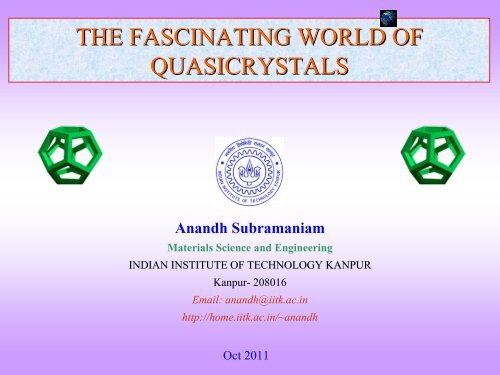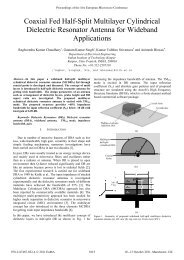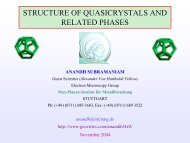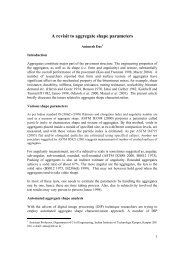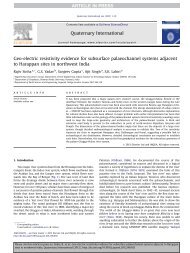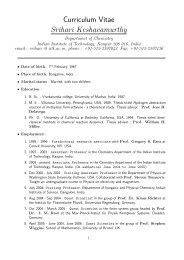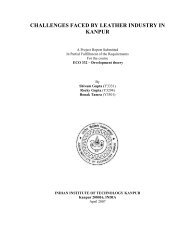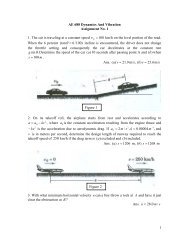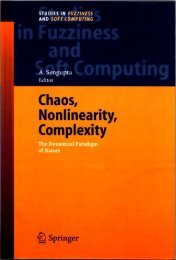THE FASCINATING WORLD OF QUASICRYSTALS - iitk.ac.in ...
THE FASCINATING WORLD OF QUASICRYSTALS - iitk.ac.in ...
THE FASCINATING WORLD OF QUASICRYSTALS - iitk.ac.in ...
You also want an ePaper? Increase the reach of your titles
YUMPU automatically turns print PDFs into web optimized ePapers that Google loves.
<strong>THE</strong> <strong>FASCINATING</strong> <strong>WORLD</strong> <strong>OF</strong><br />
<strong>QUASICRYSTALS</strong><br />
Anandh Subramaniam<br />
Materials Science and Eng<strong>in</strong>eer<strong>in</strong>g<br />
INDIAN INSTITUTE <strong>OF</strong> TECHNOLOGY KANPUR<br />
Kanpur- 208016<br />
Email: anandh@<strong>iitk</strong>.<strong>ac</strong>.<strong>in</strong><br />
http://home.<strong>iitk</strong>.<strong>ac</strong>.<strong>in</strong>/~anandh<br />
Oct 2011
Daniel Shechtman
7 April 1982<br />
8 April 1982<br />
GLASS<br />
(AMORPHOUS)<br />
GLASS<br />
(AMORPHOUS)<br />
SOLIDS<br />
Based on Structure<br />
SOLIDS<br />
Based on Structure<br />
QUASI CRYSTALS<br />
CRYSTALS<br />
CRYSTALS
A leaf from a diary…<br />
Daniel Shechtman<br />
Born: January 24, 1941<br />
Enter the Decagon!<br />
<br />
7 April 1982<br />
8 April 1982<br />
12 Nov 1984
Pa<strong>in</strong>t<strong>in</strong>g by Dr. Alok S<strong>in</strong>gh, 1993
“If you are a scientist and believe <strong>in</strong> <strong>in</strong> your results, then fight for the<br />
truth”. “Listen to to others, but fight for what you believe <strong>in</strong>…”<br />
-<br />
DAN SHECHTMAN<br />
"I must have shared with you my first ever meet<strong>in</strong>g with him <strong>in</strong> July this year.<br />
I was <strong>in</strong>vited to Ames Lab by Mat Kramer and I was sitt<strong>in</strong>g <strong>in</strong> his office and<br />
told him "I have been wait<strong>in</strong>g to meet Prof. Shechtman from my PhD days".<br />
That was the time one person entered his office and was ask<strong>in</strong>g Mat, "Mat, I<br />
have been search<strong>in</strong>g for the glue for ion mill<strong>in</strong>g my sample and could not f<strong>in</strong>d<br />
it <strong>in</strong> the lab. Can you please let me know". Mat tuned towards me and told me<br />
"the man you are look<strong>in</strong>g forward to meet is here". He was about to celebrate<br />
his 70th birthday <strong>in</strong> a few days from then. That speaks volumes about the<br />
commitment to research from this great scientist."<br />
– B.S. MURTHY
Why did it take so long?<br />
<br />
Are QC only made of rare-<br />
“hard to f<strong>in</strong>d”<br />
elements?<br />
No! Most of them conta<strong>in</strong> common elements like Al, Mn, Mg, Cu, Fe…<br />
Do we require ‘difficult conditions for synthesis’- High temperature, High<br />
pressure,…?<br />
They even<br />
No! Many of them can be produced by simple cast<strong>in</strong>g (e.g. AlCuFe, MgZnY…) occur naturally<br />
<br />
Hav<strong>in</strong>g produced them-<br />
are they ‘unstable’<br />
with small lifetimes?<br />
No! Some of them are so stable (at RT) that they would survive for millennia (but for<br />
corrosion!)<br />
<br />
Element 117 (with 177 neutrons) has a half life of 78 ms<br />
Do we need extremely sensitive experimentation (like neutron diffr<strong>ac</strong>tion…) to<br />
detect their presence/identify them?<br />
No! All you need is a Transmission Electron Microscope (TEM) (that too without EELS,<br />
EDXS… however, HREM would help!)
<strong>QUASICRYSTALS</strong>: <strong>THE</strong> PRESAGES!
Gunbad-i<br />
Kabud<br />
tomb <strong>in</strong> Maragha, Iran, 1197 AD<br />
Darb-I Imam shr<strong>in</strong>e, Isfaha, Iran, 1453 AD<br />
1453 AD
PENROSE TILING<br />
The til<strong>in</strong>g has only one<br />
po<strong>in</strong>t of global 5-fold<br />
symmetry (the centre of<br />
the pattern)<br />
However if we<br />
obta<strong>in</strong> a diffr<strong>ac</strong>tion<br />
pattern (FFT) of<br />
any ‘broad’ region<br />
<strong>in</strong> the til<strong>in</strong>g, we will<br />
get a 10-fold<br />
pattern!<br />
(we get a 10-fold <strong>in</strong>stead of a<br />
5-fold because the SAD pattern<br />
has <strong>in</strong>version symmetry)<br />
The til<strong>in</strong>g has regions of<br />
local 5-fold symmetry<br />
R. Penrose, “Pentaplexity”, Eureka, 39, 16, 1978<br />
M. Gardner, Sci. Am. 236 (1977) 110
A brief history of aperiodic<br />
<br />
<br />
<br />
<br />
Berger, 1966 20,000<br />
Rob<strong>in</strong>son, 1971 6 tiles<br />
Penrose 1<br />
Penrose 2<br />
, 1974 4 (6) tiles<br />
, 1978 2<br />
tiles<br />
til<strong>in</strong>gs<br />
tiles (then to 104 tiles)<br />
R. Berger, Mem. Am. Math. Soc., No.66, 1966.<br />
R.W. Rob<strong>in</strong>son, Invent. Math., 12, 177, 1971.<br />
[1] R. Penrose, Bull. Inst. Math. Appl., 10, 266, 1974.<br />
[2] R. Penrose, “Pentaplexity”, Eureka, 39, 16, 1978.
Penrose versus Kepler (Harmonice Mundi, 1619)<br />
Kepler<br />
Kepler<br />
concluded that the pattern would never repeat-<br />
Penrose’s Pattern<br />
Kepler’s Pattern<br />
there would always be “surprises”<br />
had anticipated the concept of aperiodic til<strong>in</strong>g by 350 years!
Wonders of Numbers:<br />
Adventures <strong>in</strong> Mathematics,<br />
M<strong>in</strong>d and Mean<strong>in</strong>g<br />
Clifford A Pickover<br />
A Circle has been pl<strong>ac</strong>ed on e<strong>ac</strong>h quasi-lattice po<strong>in</strong>t<br />
of the 2D pattern to model a possible atomic structure
WHAT IS A CRYSTAL?
Crystal =<br />
Sp<strong>ac</strong>e group (how to repeat)<br />
+<br />
Asymmetric unit (Motif’: what to repeat)<br />
+<br />
Wyckoff positions<br />
WHAT IS A CRYSTAL?<br />
a<br />
=<br />
a<br />
+<br />
Glide reflection<br />
operator<br />
Symbol g may also be used<br />
+Wyckoff label ‘a’<br />
Positions entities<br />
with respect to<br />
symmetry operators<br />
Usually asymmetric units are regions of sp<strong>ac</strong>e- which conta<strong>in</strong> the entities (e.g. atoms, molecules)
Crystals have certa<strong>in</strong> symmetries<br />
t Translation<br />
R Rotation<br />
R Roto-<strong>in</strong>version<br />
G Glide reflection<br />
S Screw axis<br />
<br />
Symmetry operators<br />
t<br />
<br />
R Inversion R Mirror<br />
Takes object to the same form<br />
Takes object to the enantiomorphic form<br />
m
3 out of the 5 Platonic solids have the symmetries seen <strong>in</strong> the<br />
crystall<strong>in</strong>e world<br />
i.e. the symmetries of the Icosahedron and its dual the Dodecahedron are<br />
not found <strong>in</strong> crystals<br />
These symmetries (rotation,<br />
mirror, <strong>in</strong>version) are also<br />
expressed w.r.t. the external<br />
shape of the crystal<br />
Pyrite<br />
Cube<br />
Rüdiger Appel, http://www.3quarks.com/GIF-Animations/PlatonicSolids/<br />
Plato wrote about these solids <strong>in</strong> the dialogue Timaeus c.360 B.C.<br />
Fluorite<br />
Octahedron<br />
http://en.wikipedia.org/wiki/Crystal_habit http://www.galleries.com/m<strong>in</strong>erals/property/crystal.htm
HOW IS A QUASICRYSTAL DIFFERENT<br />
FROM A CRYSTAL?
Dodecahedral<br />
s<strong>in</strong>gle<br />
quasicrystal<br />
[1] I.R. Fisher et al., Phil Mag B 77 (1998) 1601<br />
[2] Rüdiger diger Appel, Appel http://www.3quarks.com/GIF-Animations/PlatonicSolids/<br />
FOUND!<br />
<strong>THE</strong> MISSING PLATONIC SOLID<br />
m<br />
35<br />
[1]<br />
Mg-Zn-Ho<br />
Octahedron and icosahedron were discovered by Theaetetus, a contemporary of Plato<br />
[2]
<strong>QUASICRYSTALS</strong> (QC)<br />
ORDERED PERIODIC QC ARE<br />
ORDERED<br />
STRUCTURES<br />
WHICH ARE<br />
NOT<br />
PERIODIC<br />
CRYSTALS <br />
QC <br />
AMORPHOUS
t translation<br />
<strong>in</strong>flation<br />
SYMMETRY<br />
CRYSTAL QUASICRYSTAL<br />
RC rotation 2, crystallographic<br />
3, 4, 6<br />
RCQ RC + 5, other 8, 10, 12<br />
t <br />
R C R CQ<br />
* Quasicrystals can have allowed and disallowed crystallographic symmetries<br />
QC are char<strong>ac</strong>terized by Inflationary<br />
Symmetry and can have disallowed<br />
crystallographic symmetries*
DIMENSION <strong>OF</strong> QUASIPERIODICITY (QP)<br />
QC as a crystal?<br />
QC can be thought of as crystals <strong>in</strong> higher<br />
dimensions<br />
(which are projected on to lower<br />
dimensions → lose their periodicity*)<br />
* At least <strong>in</strong> one dimension<br />
QC can have quasiperiodicity along 1,2 or 3<br />
dimensions<br />
(at least one dimension should be<br />
quasiperiodic)<br />
QP XAL<br />
1 4<br />
2 5<br />
3 6
QUASIPERIODICITY & INFLATIONARY SYMMETRY
The Fibon<strong>ac</strong>ci sequence has a curious connection with quasicrystals* via the GOLDEN MEAN ()<br />
<strong>THE</strong> FIBONACCI SEQUENCE<br />
Fibon<strong>ac</strong>ci 1 1 2 3 5 8 13 21 34 ... <br />
Ratio 1/1 2/1 3/2 5/3 8/5 13/8 21/13 34/21 ... = ( 1+5)/2<br />
The ratio of<br />
successive terms of<br />
the Fibon<strong>ac</strong>ci<br />
sequence converges to<br />
the Golden Mean<br />
In 1202 Fibon<strong>ac</strong>ci<br />
discussed the<br />
number sequence <strong>in</strong><br />
connection with the<br />
proliferation of<br />
rabbits<br />
Where <br />
Ratio<br />
2.2<br />
2<br />
1.8<br />
1.6<br />
1.4<br />
1.2<br />
is the root of the quadratic equation: x 2<br />
1<br />
Convergence of Fibon<strong>ac</strong>ci Ratios<br />
1 2 3 4 5 6 7 8 9 10<br />
n<br />
–x –1 = 0<br />
* There are many phases of quasicrystals and some are associated with other sequences and other irrational numbers<br />
1.618… x 1<br />
x<br />
<br />
1 x<br />
2<br />
x x<br />
10
Rational<br />
Approximants<br />
E<strong>ac</strong>h one of these units<br />
(before we obta<strong>in</strong> the 1D<br />
quasilattice <strong>in</strong> the limit)<br />
can be used to get a<br />
crystal (by repetition:<br />
e.g. AB AB AB…or<br />
BAB BAB BAB…)<br />
In the limit we obta<strong>in</strong> the<br />
1D Quasilattice<br />
A<br />
B<br />
B A<br />
B A B<br />
B A B B A<br />
B A B B A B A B<br />
B A B B A B A B B A B B A<br />
1-D QC<br />
Deflated<br />
sequence<br />
<br />
Schematic diagram show<strong>in</strong>g the structural analogue of the Fibon<strong>ac</strong>ci sequence<br />
lead<strong>in</strong>g to a 1-D QC<br />
a<br />
b<br />
ba<br />
bab<br />
babba<br />
Note: the deflated sequence is<br />
identical to the orig<strong>in</strong>al sequence
Where is the Golden Mean?<br />
<br />
<br />
In the ratio of lengths<br />
In the ratio of numbers<br />
n<br />
n<br />
B<br />
A<br />
<br />
L<br />
L<br />
A<br />
B<br />
<br />
1<br />
1 1<br />
1<br />
1<br />
1<br />
1<br />
1 1
Inflationary symmetry <strong>in</strong> the Penrose til<strong>in</strong>g<br />
Inflated til<strong>in</strong>g<br />
The <strong>in</strong>flated tiles<br />
can be used to<br />
create an <strong>in</strong>flated<br />
replica of the<br />
orig<strong>in</strong>al til<strong>in</strong>g
HOW IS A DIFFRACTION PATTERN FROM A CRYSTAL<br />
DIFFERENT FROM THAT <strong>OF</strong> A QUASICRYSTAL?
Let us look at the Selected Area Diffr<strong>ac</strong>tion Pattern (SAD) from a crystal → the spots/peaks are arranged periodically<br />
Superlattice spots<br />
The spots are<br />
periodically<br />
arranged<br />
[112]<br />
[111] [011]<br />
SAD patterns from a BCC phase (a = 10.7 Å) <strong>in</strong> as-cast Mg 4 Zn 94 Y 2 alloy show<strong>in</strong>g important zones
Now let us look at the SAD pattern from a quasicrystal from the same alloy system (Mg-Zn-Y)<br />
[1 <br />
0]<br />
[0 0 1]<br />
The spots<br />
show<br />
<strong>in</strong>flationary<br />
symmetry<br />
Expla<strong>in</strong>ed <strong>in</strong><br />
the next slide<br />
SAD patterns from as-cast Mg 23 Zn 68 Y 9 show<strong>in</strong>g the formation of F<strong>ac</strong>e Centred Icosahedral QC<br />
[1 1 1]<br />
[<br />
1 3 + ]
DIFFRACTION PATTERN<br />
5-fold SAD pattern<br />
from as-cast<br />
alloy<br />
Mg23Zn68Y9 Note the 10-fold pattern<br />
1<br />
2 3 4<br />
Successive spots are at a distance <strong>in</strong>flated by <br />
Inflationary symmetry
STRUCTURE <strong>OF</strong> <strong>QUASICRYSTALS</strong><br />
QUASILATTICE APPROACH<br />
(Construction of a quasilattice followed by the decoration of the lattice by atoms)<br />
PROJECTION FORMALISM<br />
TILINGS AND COVERINGS<br />
CLUSTER BASED CONSTRUCTION<br />
(local symmetry and stage-wise construction are given importance)<br />
<br />
<br />
TRIACONTAHEDRON (45 Atoms)<br />
MACKAY ICOSAHEDRON (55 Atoms)<br />
BERGMAN CLUSTER (105 Atoms)
E2<br />
HIGHER DIMENSIONS ARE NEAT<br />
REGULAR<br />
PENTAGONS<br />
Regular pentagons cannot tile E2 sp<strong>ac</strong>e but can tile<br />
S2 sp<strong>ac</strong>e (which is embedded <strong>in</strong> E3 sp<strong>ac</strong>e)<br />
GAPS<br />
S2 <br />
E3<br />
SPACE FILLING
For crystals We require two basis vectors to <strong>in</strong>dex the diffr<strong>ac</strong>tion pattern <strong>in</strong> 2D<br />
For quasicrystals <br />
We require more than two basis vectors to <strong>in</strong>dex the diffr<strong>ac</strong>tion diffr<strong>ac</strong>tion<br />
pattern <strong>in</strong> 2D<br />
For this SAD pattern<br />
we require 5 basis vectors<br />
(4 <strong>in</strong>dependent)<br />
to <strong>in</strong>dex the diffr<strong>ac</strong>tion pattern <strong>in</strong> 2D
PROJECTION METHOD<br />
QC considered a crystal <strong>in</strong> higher dimension → projection to lower dimension can<br />
give a crystal or a quasicrystal<br />
2D 1D<br />
E W<strong>in</strong>dow<br />
<br />
Slope = Tan ()<br />
e 2<br />
Irrational QC<br />
e 1<br />
Rational RA (XAL)<br />
E ||<br />
<br />
E ||<br />
To get RA <br />
approximations are made<br />
<strong>in</strong> E (i.e to )<br />
x' Cos S<strong>in</strong> x R <br />
y' S<strong>in</strong> Cosy
1D<br />
<br />
2D<br />
<br />
Penrose Til<strong>in</strong>g<br />
2 1 1<br />
<br />
<br />
0 3 3 3 - 3<br />
<br />
R2<br />
1 1 <br />
<br />
<br />
0 3- 3 3 3 <br />
2 2 2 2 2 <br />
1-D QC<br />
B A B B A B A B B A B B A<br />
<br />
Octogonal<br />
<br />
Til<strong>in</strong>g<br />
1 0 1 1 <br />
2 2 <br />
<br />
0 1 1<br />
1 <br />
2 2 <br />
R <br />
1 1 1 0 <br />
2 2<br />
<br />
1 1<br />
0 1<br />
<br />
<br />
<br />
2 2
3D<br />
5-fold<br />
[1 <br />
0]<br />
Note the occurrence of<br />
irrational Miller <strong>in</strong>dices<br />
<br />
<br />
<br />
<br />
ICOSAHEDRAL QUASILATTICE<br />
The icosahedral quasilattice is the 3D analogue of the Penrose til<strong>in</strong>g.<br />
It is quasiperiodic <strong>in</strong> all three dimensions.<br />
The quasilattice can be generated by projection from 6D.<br />
It has got a char<strong>ac</strong>teristic 5-fold symmetry.<br />
3-fold<br />
[2+1 <br />
0]<br />
1 0 1<br />
0 <br />
<br />
1 0 0 1<br />
<br />
<br />
<br />
<br />
0 1 0 1<br />
<br />
R <br />
1 0 1<br />
0 <br />
1 0 1 0 <br />
<br />
0 1 0 1<br />
2-fold [+1 1]
Cluster Based Construction<br />
Rhombic Tri<strong>ac</strong>ontahedron<br />
Bergman cluster<br />
Kre<strong>in</strong>er, G., and Franzen, H. F., J. Alloys and Compounds, 221 (1995) 15<br />
(a) Bergman, G., Waugh, J. L. T., and Paul<strong>in</strong>g, L., Acta Cryst., 10 (1957) 2454<br />
(b) Ranganathan, S., and Chattopadhyay, K., Annu. Rev. Mater. Sci., 21 (1991) 437<br />
(a) (b)<br />
M<strong>ac</strong>kay double icosahedron<br />
Hiraga, K et al, S., Phil. Mag. B67 (1993) 193
Comparison of a crystal with a quasicrystal<br />
CRYSTAL QUASICRYSTAL<br />
Translational symmetry Inflationary<br />
symmetry<br />
Crystallographic rotational symmetries Allowed + some disallowed rotational<br />
symmetries<br />
S<strong>in</strong>gle unit cell to generate the structure Two prototiles are required to generate the<br />
structure (cover<strong>in</strong>g possible with one tile!)<br />
3D periodic Periodic <strong>in</strong> higher dimensions<br />
Sharp peaks <strong>in</strong> reciprocal sp<strong>ac</strong>e with Sharp peaks <strong>in</strong> reciprocal sp<strong>ac</strong>e with<br />
translational symmetry<br />
<strong>in</strong>flationary symmetry<br />
Underly<strong>in</strong>g metric is a rational number Irrational metric<br />
Usually made of ‘small’<br />
clusters Large clusters
SYSTEMS FORMING <strong>QUASICRYSTALS</strong><br />
&<br />
TYPES <strong>OF</strong> <strong>QUASICRYSTALS</strong>
List of quasicrystals with diverse k<strong>in</strong>ds of symmetries<br />
Type QP + Rank Metric Symmetry System Reference<br />
Icosahedral 3 D 6 (5)<br />
Cubic 3D 6 3<br />
Tetrahedral 3D 6 3<br />
m3 _<br />
5 _<br />
_<br />
43m<br />
m3 _<br />
AlMn Shechtman et al., 1984<br />
VNiSi<br />
AlLiCu<br />
Feng et al., 1989<br />
Donnadieu, 1994<br />
Decagonal 2D 5 (5) 10/mmm AlMn Chattopadhyay et al., 1985<br />
and Bendersky, 1985<br />
Dodecagonal 2D 5 3 12/mmm NiCr Ishimasa et al., 1985<br />
Octagonal 2D 5 2 8/mmm VNiSi,<br />
Pentagonal 2D 5 (5)<br />
5m<br />
_<br />
CrNiSi<br />
AlCuFe<br />
Wang et al., 1987<br />
Bancel, 1993<br />
Hexagonal 2D 5 3 6/mmm AlCr Selke et al., 1994<br />
Trigonal 1D 4 3<br />
3m<br />
_<br />
AlCuNi<br />
Chattopadhyay et al., 1987<br />
Digonal 1D 4 2 222 AlCuCo He et al., 1988
Naturally Occurr<strong>in</strong>g QC<br />
<br />
First naturally occurr<strong>in</strong>g QC was reported associated with the m<strong>in</strong>eral Khatyrkite.
Indian Contributions<br />
http://www.iucr.org/news/newsletter/volume-15/number-4/crystallography-<strong>in</strong>-<strong>in</strong>dia<br />
“However, India missed some opportunities <strong>in</strong> this area. Early work of<br />
T.R. Anantharaman on Mn-Ga alloys and G.V.S. Sastry and C. Suryanarayana<br />
(BHU) on Al-Pd alloys came tantaliz<strong>in</strong>gly close to the discovery of quasicrystals”.<br />
Conference <strong>in</strong> Honour of Prof. T.R. Anantharaman<br />
IITK<br />
S. Lele<br />
S. Ranganathan<br />
C. Suryanarayana<br />
http://www.<strong>iitk</strong>.<strong>ac</strong>.<strong>in</strong>/<strong>in</strong>focell/announce/metallo/collection.htm<br />
G.V.S SASTRY
Allowed crystallographic symmetrytiled aperiodically<br />
Discovery of the decagonal phase<br />
Basis for synthesis of QC
1-D quasiperiodicity
Approximant to 7fold<br />
quasilattice<br />
= 2<br />
= 1<br />
Icosahedral Quasicrystal = 3<br />
Decagonal<br />
Hexagonal<br />
Quasicrystal<br />
= 1<br />
Quasicrystal<br />
Digonal Pentagonal Cubic R.A.S. Trigonal Hexagonal<br />
Quasicrystal Quasicrystal M<strong>ac</strong>kay Bergman Quasicrystal R.A.S.<br />
Orthorhombic<br />
Orthorhombic<br />
R.A.S.<br />
R.A.S<br />
Taylor<br />
Rob<strong>in</strong>son<br />
Little<br />
R.A.S. Monocl<strong>in</strong>ic<br />
Monocl<strong>in</strong>ic<br />
R.A.S.<br />
R.A.S.<br />
= 90 o<br />
= 108 o<br />
Trigonal and Pentagonal<br />
quasilattices<br />
3 2<br />
x x 2x10 Trigonal<br />
R.A.S.<br />
Orthorhombic<br />
R.A.S.<br />
Monocl<strong>in</strong>ic<br />
R.A.S.<br />
120 o<br />
First observation of a<br />
relation between five-fold<br />
and hexagonal symmetry<br />
Unified view of quasicrystals,<br />
rational approximants and<br />
related structures<br />
Fundamental<br />
work on<br />
V<strong>ac</strong>ancy<br />
Ordered Phases<br />
Uniform deformation along the arrow of the [0 0 1] 2-fold pattern<br />
from IQC giv<strong>in</strong>g rise to a pattern similar to the [ 1 3 + ] pattern


